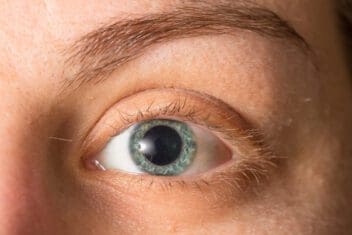Eye Dilation: A Guide (How Long It Lasts, Side Effects, More)
Home / Eye Conditions & Eye Diseases /
Last Updated:
Eye dilation works to increase the size of your pupils. Doing this allows the doctor to look at your retina and optic nerve to determine their level of health.
Table of Contents
For most people, their eyes remain dilated for four to six hours. It takes approximately 30 minutes for the pupils to dilate enough for the doctor to perform the eye examination.
Everyone reacts differently to the eye drops used to dilate the eyes. While the exact timeline will vary, you generally have to wait at least a few hours for the effects to wear off.

The actual dilation of your eyes does not cause discomfort. But when your eyes are dilated, you may feel somewhat uncomfortable since your eyes have far less protection against light.
Your doctor will provide you with instructions on how to care for your eyes until the effects of the dilation wear off. For example, you can usually drive, but if your eyes are especially sensitive, it is best to avoid driving until the effects are gone.
What Is Eye Dilation?
During an eye examination, the doctor may dilate your eyes so they can look at the structures located at the back of your eye. They are looking for abnormalities that may indicate the following conditions:
- High blood pressure: The retina’s blood vessels can experience damage if you have high blood pressure that goes untreated, especially long term.
- Retinal detachment: This refers to the retina pulling away from the blood vessels that are attached to it. As a result, the retina gets insufficient nutrients and oxygen.
- Diabetes: People with diabetes are at risk for diabetic retinopathy, especially if your high blood sugar levels are uncontrolled over the long term. This condition affects the retina’s blood vessels.
- Macular degeneration: This condition is characterized by the macula element of the retina sustaining damage. It can result in vision loss that is irreversible.
- Glaucoma: There are different types of glaucoma that result in damage to the optic nerve. Eye pressure getting abnormally high is the typical cause of the damage.
You deserve clear vision. We can help.
With 135+ locations and over 2.5 million procedures performed, our board-certified eye surgeons deliver results you can trust. Your journey to better vision starts here.
Eye dilation may be done as part of a comprehensive eye examination or to look for an acute injury, such as a retinal detachment. No matter the reason for the dilation, it is performed in the same manner. The doctor will input eye drops that work to widen your pupils.
How often you need to have your pupils dilated will depend on several factors. For those with relatively good overall health, your doctor may only recommend it when you have routine eye examinations. The following may impact the schedule your doctor recommends:
- You are over 60 years old.
- You have a history of retinal detachment or other eye issues that affect the structures at the back of your eye.
- You are experiencing new eye symptoms.
- You are Hispanic or African American, which means you have an increased glaucoma risk.
- You have diabetes or other health issues that can affect your eye health.
How Does It Work?
For eye dilation, or mydriasis, your doctor inputs eye drops, and it takes 20 to 30 minutes for your pupils to achieve full dilation. If your eyes are lighter in color, they tend to dilate faster than brown eyes.
Once your pupils achieve full dilation, your doctor will examine your eyes using a magnifying lens. This allows them to better visualize your macula, retina, and optic nerve.
How Long Does Dilation Last?
The average dilation lasts four to six hours. The exact eye drops the doctor uses impact how long your eyes remain dilated.
Commonly used eye drops include:
- Phenylephrine
- Hydroxyamphetamine
- Atropine
- Tropicamide
- Cyclopentolate
The doctor usually inputs two types of drops into your eyes to dilate your pupils. One of the drops used causes the muscles that control the pupil to contract so the pupil becomes larger. Phenylephrine is an example of this type of eye drop.
The second type that is used relaxes the muscle that is responsible for the eye lens focusing. It also relaxes the muscles that allow the pupil to become smaller. Cyclopentolate is an example of this type of eye drop.
If you are having eye dilation performed for the first time, you should plan to experience dilation for at least six hours. Consider getting a ride home from the doctor, and make sure you have sunglasses to reduce the light sensitivity that is common when your pupils are dilated.
Can You Reduce Dilated Eyes Faster?
How long your eyes remain dilated depends on you and how you respond to the eye drops the doctor uses.

Since it can be hard to do things like read or see a television screen if your vision is blurry, it is best to avoid these activities until the effects wear off.
What Are the Side Effects of Eye Dilation?
Once your eyes are dilated, it is common for your vision to be blurry. If you try to focus on nearby objects, it can be difficult.
Bright lights can cause discomfort since your eyes will be very light sensitive. The eye drops the doctor uses may sting for a few seconds after they are applied.
These side effects usually go away as your pupils start to reduce in size. For most people, they are mild and do not cause intense discomfort. If any of the side effects are particularly bothersome, call your doctor.
If you wear contact lenses, your doctor will suggest that you avoid putting them in until the dilation reduces. They may recommend that you don’t wear contacts until the next day. If you wear regular eyeglasses, you should be able to put them on as soon as the doctor completes your eye dilation examination.
To reduce the side effects of eye dilation, take the following steps:
- Take the rest of the day off work or school so you can rest your eyes.
- Keep your home darkened until the dilation wears off.
- Wear sunglasses when you are outside.
- Avoid driving until all the blurriness resolves.
While rare, it is possible for the eye drops to cause an allergic reaction, such as red eyes and swelling of the eyelids. If atropine is used, the following side effects are possible:
- Dry mouth
- Rapid pulse
- Fever
- Facial flushing
Compared to other eye dilation eye drops, atropine tends to be longer acting.
How Long After Eye Dilation Can You Drive?

If you do not experience any side effects affecting your vision, you can resume driving. It is typically recommended that you avoid driving if you experience effects, such as blurriness or trouble focusing on objects.
If it’s your first dilation eye examination, plan on getting a ride home since you don’t know how the dilation will affect you. This ensures you are prepared just in case your vision is affected enough that driving yourself home could be dangerous.
You deserve clear vision. We can help.
With 135+ locations and over 2.5 million procedures performed, our board-certified eye surgeons deliver results you can trust. Your journey to better vision starts here.
Eye Dilation as a Treatment
Dilating the eyes may benefit certain eye conditions, such as lazy eye and inflammation in the eye. When used as a treatment, the same eye drops used to dilate your eyes during an examination are used. The overall process is the same.
Dilation is usually done as part of a comprehensive eye examination. It may also be done in an acute setting to evaluate a possible injury to the eye.
Eye Dilation Costs
Most often, eye dilation is included in the total cost of a comprehensive eye exam, which averages $50 to $150 without insurance.
If billed on its own, dilation generally costs about $30 to $50.
Undilated vs. Dilated Eye Exam
In an undilated eye exam, the optometrist can check:
- Your vision
- Structure of the undilated pupil
- Iris
- Visual field
- Eye’s drainage angle
With a dilated eye exam, the doctor can also check:
- Back of your eye
- Entire retina
- Optic nerve
- Macula
Essentially, dilation lets more light into your eye, so the doctor is better able to see the entire eye.
Eye Dilation FAQs
Does eye dilation hurt?
No, dilation does not cause pain. You may experience sensitivity to light and some blurriness, however.
Do I need eye dilation?
It’s generally recommended as part of a comprehensive eye exam, particularly if you wear glasses or contact lenses, or if you are over 60. If you are young and have no vision issues, you may not need to have your eyes dilated at every eye exam.
What types of doctors do eye dilation?
Optometrists and ophthalmologists generally dilate eyes.
How long does it take for eye dilation to wear off?
Eye dilation generally lasts 4 to 6 hours. Then, the medication has usually fully worn off.
When can I drive after eye dilation?
It’s recommended to wait 4 to 6 hours before driving after eye dilation.
You deserve clear vision. We can help.
With 135+ locations and over 2.5 million procedures performed, our board-certified eye surgeons deliver results you can trust. Your journey to better vision starts here.
References
- Eye Dilation: Necessary With Every Eye Exam? (February 2018). Mayo Clinic.
- What to Expect When Your Eyes Are Dilated. (September 2019). American Academy of Ophthalmology.
- What Is a Comprehensive Dilated Eye Exam? National Eye Institute.
- All About Red Caps: Mydriatics and Cycloplegics. (June 2019). Optometry Times.
- Eye Dilation. Children’s Hospital of Philadelphia.
- The Eyes Have It for High Blood Pressure Clues. (December 2018). American Heart Association.
- What Are Dilating Eye Drops? (May 2020). American Academy of Ophthalmology.
- Facts About Diabetic Eye Disease. National Eye Institute.
- Dilating Eye Drops. American Association for Pediatric Ophthalmology and Strabismus.
- How Much Does an Eye Exam Cost in California? (July 2021). Everything What.
This content is for informational purposes only. It may have been reviewed by a licensed physician, but is not intended to serve as a substitute for professional medical advice. Always consult your healthcare provider with any health concerns. For more, read our Privacy Policy and Editorial Policy.